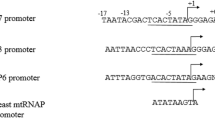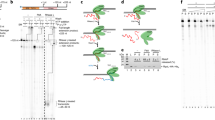Summary
The TRP1 gene of Saccharomyces cerevisiae is the only TRP gene which is not derepressible by the general control regulatory system. In the TRP1 promoter transcription starts at five initiation sites, organized in two clusters. The two transcripts of the first, more upstream cluster include a long leader sequence of approximately 200 bp. A transcriptional terminator element located in the 5′ region of the TRP1 gene is essential for accurate gene expression. In partial TRP1 promoters lacking the terminator, like the original EcoRI TRP1 fragment used in numberous vectors, plasmid-encoded transcription is initiated predominantly in adjacent vector regions, resulting mainly in large, poorly translated transcripts. This poor translation is not due to mRNA instability. The effect can be suppressed by introducing artificial transcription barriers between vector sequences and the truncated EcoRI TRP1 fragment.
Similar content being viewed by others
Abbreviations
- CDRP:
-
1-(o-carboxyphenylamino-)-1-deoxyribulose 5-phosphate
- InGP:
-
indoleglycerol phosphate
- PRA:
-
N-(5′-phosphoribosyl-1-), anthranilate
- trp:
-
tryptophan
References
Aebi M, Niederberger P, Hütter R (1982) Isolation of the TRP2 and TRP3 genes of Saccharomyces cerevisiae. Curr Genet 5:39–46
Aebi M, Furter R, Prantl F, Niederberger P, Hütter R (1984) Structure and function of the TRP3 gene of Saccharomyces cerevisiae: Analysis of transcription, promoter sequence, and sequence coding for a glutamine amidotrasferase. Curr Genet 8:165–172
Aviv H, Leder P (1972) Purification of biologically active globin mRNA by chromatography on oligo thymidilic cellulose. Proc Natl Acad Sci USA 69:1408–1412
Bajwa W, Meyhack B, Rudolph H, Schweingruber AM, Hinnen H (1984) Structural analysis of the two tandemly repeated acid phosphatase genes in yeast. Nuclei Acids. Res 12:7721–7739
Beggs JD (1978) Transformation of yeast by a replicating hybrid plasmid. Nature 275:104–109
Berk AJ, Sharp PA (1977) Sizing and mapping of early adenovirus mRNAs by gel electrophoresis of S1 endonuclease-digested hybrids. Cell 12:721–732
Birnboim HC, Doly J (1979) A rapid alkaline extraction procedure for screening recombinant plasmid DNA. Nucleic Acids Res 7:1513–1523
Braus G, Furter R, Prantl F, Niederberger P, Hütter R (1985) Arrangement of genes TRP1 and TRP3 of Saccharomyces cerevisiae strains. Arch Microbiol 142:383–388
Casadaban MJ, Martinez-Arias A, Shapira SK, Chou J (1983) β-galactosidase gene fusions for analyzing gene expression in Escherichia coli and yeast. Methods Enzymol 100:293–308
Chen W, Struhl K (1985) Yeast mRNA initation sites are determined primarily by specific sequences, not by the distance from the TATA element. EMBO J 4:3273–3280
Creighton TE (1968) The nonenzymatic preparation in solution of N-(5′-phosphoribosyl)anthranilic acid, an intermediate in tryptophan biosynthesis. J Biol Chem 243:5605–5609
Creighton TE, Yanofsky C (1970) Chorismate to tryptophan (Escherichia coli) — anthranilate synthetase, PRtransferase, PRAisomerase, InGPsynthetase, tryptophan synthetase. Methods Enzymol 17A:365–380
Dobson MJ, Tuite MF, Mellor J, Roberts NA, King RM, Burke DC, Kingsman AJ, Kingsman SM (1983) Expression in Saccharomyces, cerevisiae of human interferon-alpha directed by the TRP1 5′ region. Nucleic Acids Res 11:2287–2302
Donahue TF, Farabaugh PJ, Fink GR (1982) The nucleotide sequence of the HIS4 region of yeast. Gene 18:47–59
Donahue TF, Daves RS, Lucchini G, Fink GR (1983) A short nucleotide sequence required for regulation, of HIS4 by the general control system of yeast. Cell 32:89–98
Dynan WS, Tjian R (1985) Control of eukaryotic messenger RNA synthesis by sequence-specific DNA binding proteins. Nature 316:774–777
Fantes PA, Roberts LM, Hütter R (1976) Free tryptophan pool and tryptophan biosynthetic enzymes in Saccharomyces cerevisiae. Arch Microbiol 107:207–214
Furter R, Paravicini G, Aebi M, Braus G, Prantl F, Niederberger P, Hütter R (1986) The TRP4 gene of Saccharomyces cerevisiae: isolation and structural analysis. Nucleic Acids Res 14:6357–6373
Gruntein M, Hogness DS (1975) Colony hybridization: method for the isolation of cloned DNAs that contain a specific gene. Proc Natl Acad Sci USA 72:3961–3965
Guarente L, Ptashne M (1981) Fusion of the Escherichia, coli lacZ to the cytochrome c gene of Saccharomyces cerevisiae. Proc Natl Acad Sci USA 78:2199–2203
Hahn S, Hoar ET, Guarente L (1985) Each of three “TATA elements” specifies a subset of the transcription initiation sites at the CYC-1 promoter of Saccharomyces cerevisiae. Proc Natl Acad Sci USA 82:8562–8566
Herbert D, Phipps PJ, Strange RE (1971) Chemical analysis of microbioal cells. Methods Microbiol 5B:209–344
Hinnebusch AG (1986) The general control of amino acid biosynthetic genes in the yeast Saccharomyces cerevisiae. CRC Crit Rev Biochem 21:277–317
Hinnen A, Hicks JB, Fink GR (1978) Transfomation of yeast. Proc Natl Acad Sci USA 75:1929–1933
Hope IA, Struhl K (1985) GCN4 protein, synthesized in vitro, binds to HIS3 regulatory sequences: implications for the general control of amino acid biosynthetic genes in yeast. Cell 43:177–188
Hsiao C, Carbon J (1979) High-frequency transformation of yeast by plasmids containing the cloned ARG4 gene. Proc Natl Acad Sci USA 76:3829–3833
Humphreys GO, Willishaw GA, Anderson ES (1975) A simple method for the preparation of large quantities of pure plasmid DNA. Biochim Biophys Acta 383:457–463
Johansen H, Schümperli D, Rosenberg M (1984) Affecting gene expression by altering the length and the sequence of the 5′ leader. Proc Natl Acad Sci USA 81:7698–7702
Johnston M, Davis RW (1984) Sequences that regulate the divergent GAL1-GAL10 promoter in Saccharomyces cerevisiae. Mol Cell Biol 4:1440–1448
Kieser T (1984) Factors affecting the isolation of ccc DNA from Streptomyces lividans and Escherichia coli. Plasmid 12:19–36
Kim S, Mellor J, Kingsman AJ, Kingsman SM (1986) Multiple elements in the TRP1 promoter of Saccharomyces cerevisiae. Mol Cell Biol 6:4251–4258
Kingsman AJ, Clarke L, Mortimer RK, Carbon J (1979) Replication in Saccharomyces cerevisiae of plasmid pBR313 carrying DNA from the yeast trp1 region. Gene 7:141–152
Liu CC, Simonsen CC, Levinson AD (1984) Initiation of translation at internal AUG codons in mammalian cells. Nature 309:82–85
Lowry CV, Weiss JL, Walthall, DA, Zitomer RS (1983) Molecular sequences mediate oxygen regulation of CYC1 and a neighboring gene in yeast. Proc Natl Acad Sci USA 80:151–155
Mandel M, Higa A (1970) Calcium-dependent bacteriophage DNA infection. J Mol Biol 53:159–162
Maxam AM, Gilbert W (1980) Sequencing end-labelled DNA with base specific chemical cleavages. Methods Enzymol 65:499–560
Melton DA, Krieg PA, Rebagliati MR, Maniatis T, Zinn K, Green MR (1984) Efficient, in vitro synthesis of biologically active RNA and RNA hybridization probes from plasmids containing a bacteriophage SP6 promoter. Nucleic Acids Res 12:7035–7056
Miller JH (1972) Experiments in molecular genetics. Cold Spring Harbor Laboratory, Cold Spring Harbor, New York
Miozzari G, Niederberger P, Hütter R (1978a) Tryptophan biosynthesis in Saccharomyces cerevisiae: control of the flux through the pathway. J Bacteriol 134:48–59
Miozzari G, Niederberger P, Hütter R (1978b) Permeabilization of microorganisms by Triton X-100. Anal Biochem 90:220–233
Mueller PP, Hinnebusch AG (1986) Multiple upstream AUG codons mediate translational control of GCN4. Cell 45:201–207
Niederberger P, Aebi M, Furter R, Prantl F, Hütter R (1984) Expression of an artificial yeast TRP gene cluster in yeast and Escherichia coli. Mol Gen Genet 195:481–486
Osley MA, Gould J, Kim S, Hereford L (1986) Identification of sequences in a yeast histone promoter involved in periodic transcription. Cell 45:537–544
Panzeri L, Philippsen P (1982) Centromeric DNA from chromosome VI in Saccharomyces cerevisiae strains. EMBO J 1:1605–1611
Parent SA, Fenimore CM, Bostian KA (1985) Vector systems for the expression, analysis and cloning of DNA sequences in S. cerevisiae. Yeast 1:83–138
Rigby PWJ, Dieckmann M, Rhodes C, Berg P (1977) Labelling deoxyribonucleic acid to high specific activity in vitro by nick translation with DNA polymerase I. J Mol Biol 113:237–251
Rudolph H, Hinnen A (1987) A yeast PHO5 promoter: phosphate control elements and sequences mediating mRNA start-site selection. Proc Natl Acad Sci USA 84:1340–1344
Schürch AR, Miozzari G, Hütter R (1974) Regulation of tryptophan biosynthesis in Saccharomyces cerevisiae: mode, of action of 5-methyltryptophan and 5-methyltryptophan sensitive mutants. J Bacteriol 117:1131–1140
Sherman F, Fink GR, Lukins HB (1970) Methods in yeast genetics. Cold Spring Harbor Laboratory, New York, pp 51–53
Smith GE, Summers MD (1980) The bidirectional transfer of DNA and RNA to nitrocellulose or diazobenzyloxamethyl paper. Anal Biochem 109:123–129
Smith OH, Yanofsky C (1963) Intermediates in the biosynthesis of tryptophan. Methods Enzymol 6:590–597
Southern EM (1975) Detection of specific sequences among DNA fragments separated by gel electrophoresis. J Mol Biol 98:503–517
Struhl K (1982) The yeast his3 promoter contains at least two distinct elements. Proc Natl Acad Sci USA 79:7385–7389
Struhl K, Davis, RW (1981) Promoter mutants in the yeast his3 gene. J. Mol Biol 152:553–568
Struhl K, Stinchcomb DT, Scherer S, Davis RW (1979) High frequency transformation of yeast: Autonomous replication of hybrid DNA molecules. Proc Natl Acad Sci USA 76:1035–1039
Struhl K, Chen W, Hill DE, Hope IA, Oettinger MA (1985) Constitutive and coordinately regulated transcription of yeast genes: promoter elements, positive and negative regulatory sites, and DNA binding proteins. Cold Spring Harbor Symp Quant Biol 50:489–503
Sutcliffe JG (1979) Complete nucleotide sequence of the Escherichia coli plasmid pBR322. Cold Spring Harbor Symp Quant Biol 43:77–90
Thoma F, Simpson RT (1985) Local protein-DNA interactions may determine nucleosome positions on yeast plasmids. Nature 315:250–252
Thomas PS (1980) Hybridization of denatured RNA and small DNA fragments transfered to nitrocellulose. Proc Natl Acad Sci USA 77:5201–5205
Tschumper G, Carbon J (1980) Sequence of a yeast DNA fragment containing a chromosomal replicator, and the TRP1 gene. Gene 10:157–166
Wahl GM, Stern M, Stark GR (1979) Efficient transfer of large DNA fragments from agarose gels to diazobenzyloxymethyl paper and rapid hybridization by using dextransulfate. Proc Natl Acad Sci USA 76:3683–3687
Weaver RF, Weissmann C (1979) Mapping of RNA by a modification of the Berk-Sharp procedure: the 5′ termini of 15S β-globin mRNA have identical map coordinates. Nucleic Acids Res 7:1175–1193
Wegman J, DeMoss JA (1965) The enzymic conversion of anthranilate to indolylglycerol phosphate in Neurospora crassa. J Biol Chem 240:3781–3788
Yarger JG, Armilei G, Gorman MC (1986) Transcription terminator-like element in a Saccharomyces cerevisiae promoter region. Mol Cell Biol 6:1095–1101
Zakian VA, Scott JF (1982) Construction, replication, and chromatin structure of TRP1 RI Circle, a multi-copy synthetic plasmid derived from Saccharomyces cerevisiae chomosomal DNA Mol Cell Biol 2:221–232
Zalkin H, Yanofsky C (1982) Yeast gene TRP5: structure, function, regulation. J Biol Chem 257:1491–1500
Zalkin H, Paluh JL, van Cleemput M, Moye WS, Yanofsky C (1984) Nucleotide sequence of Saccharomyces cerevisiae genes TRP2 and TRP3 encoding bifunctional anthranilate synthase: indole-3-glycerol phosphate synthase. J Biol Chem 259:3985–3992
Zaret KS, Sherman F (1982) DNA sequence required for efficient transcription termination in yeast Cell 28:563–573
Zitomer RS, Hall BD (1976) Yeast cytochrome c messenger RNA. J Biol Chem 251:6320–6326
Author information
Authors and Affiliations
Additional information
Communicated by C.P. Hollenberg
Rights and permissions
About this article
Cite this article
Braus, G., Paravicini, G. & Hütter, R. A consensus transcription termination sequence in the promoter region is necessary for efficient gene expression of the TRP1 gene of Saccharomyces cerevisiae . Mol Gen Genet 212, 495–504 (1988). https://doi.org/10.1007/BF00330855
Received:
Issue Date:
DOI: https://doi.org/10.1007/BF00330855




